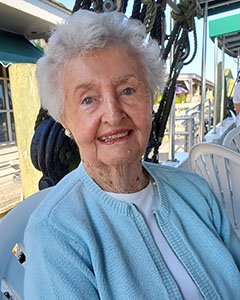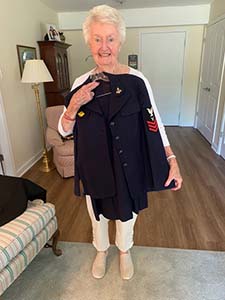It was the uniform that first caught her eye. Not the bell bottoms that the boys wore, but the deep blue, tailored cut of the WAVE uniform that brought Gloria Harnett Kerzner to the Navy recruitment office in 1944. 79 years later, as Gloria nears her 100th birthday, that uniform still hangs in her closet, as crisp and clean as ever.
“I wanted to serve my country,” says Gloria. “We all did. Everybody was so patriotic at that time and I wanted to do my part.” Gloria was already a graduate of secretarial school and working for a defense contractor near her home in New Jersey, when she finally turned 20 and could enlist as a Yeoman 3rd class. The advertisements were everywhere, looking for women to fill the roles traditionally held by men, who were needed aboard ships.
Six weeks of basic training at Hunter College in the Bronx was followed by six more weeks at Yeoman school in Cedar Falls, Iowa, before she was assigned to Lakehurst Naval Air Station, just an hour from her home. She spent her first few months there in the personnel office doing clerical work until testing to become a Yeoman 2nd class. It was shortly after that she was transferred to CNATE, the Chief Naval Air Ship Training and Experimentation unit, also located at Lakehurst. Under the command of Admiral Charles Rosendahl, CNATE kept all records and reports from airship squadrons patrolling the Eastern seaboard from Maine to Brazil. Rosendahl had piloted and been an observer on several different blimps around Europe and across the Atlantic prior to and during the war. He was in command at Lakehurst on May 6, 1937 when the Hindenberg caught fire, and led firefighting and rescue efforts during that disaster.
“Admiral Rosendahl was like the father of lighter than air,” says Gloria. “Lakehurst had all the blimps. On the Atlantic coast, we had bases from Maine all the way to Brazil. We had 3 bases in New Jersey. We had bases in Virginia, Georgia, Guantanamo Bay, Rio de Janiero. We had squadrons of blimps in all those places patrolling the coast, doing air-sea rescue, patrolling for submarines.”
Every squadron reported their activity back to Lakehurst where Gloria was assigned to the historical office, aiding in keeping extensive records of all the lighter-than-air activities during the waning years of the war. “The directive was for every squadron to compile their histories and send them to our office,” says Gloria. She and another yeoman edited and compiled all the information- on manual typewriters she adds. “That’s where I worked ‘til the end of the war.”


Gloria’s last two months in the Navy were spent in Washington, DC, doing paperwork that mustered out sailors and sent them home. After her own discharge she finished a degree in Marketing at Indiana University and went to work in New York City. She worked at several different firms in downtown New York and on Wall Street. It was a weekend trip to a resort on the Delaware River that changed her life. She met her husband Andrew, a lieutenant in the New York City fire department at the time. But he lived in Brooklyn and she lived in East Orange, New Jersey, and on their first date he almost decided it was too far a trip to make for a date with a nice woman. “It’s not exactly around the corner,” says Gloria today. Then Andrew smelled the flower she had tucked into his pocket as they said goodnight, and the rest is history.
They married in 1963 and moved into their home on Long Island, and had one daughter, Elaine. Andrew eventually became Deputy Chief of the NYC Fire Department, retiring in 1985 after 38 years. Though the couple knew of Honor Flight in New York, Gloria says they never pursued it. “I guess we just let it slide by.” Andrew had been a tail gunner on a B-29, flying sorties over Tokyo during the war. He died in 2016, and four years later Gloria finally moved to the Chicago area to be near her daughter and son-in-law, three granddaughters and a brand new great grand baby. This December 28th will be her 100th birthday.
Gloria’s daughter Elaine knew about Honor Flight Chicago and signed her mother up as soon as she was able, but it was the heart of COVID, so she has been waiting patiently for this month’s flight. Although she has seen the World War Two memorial before, she knows how powerful it can be.
“It’s magnificent,” says Gloria. She expects this trip to bring back memories, and to let all the veterans know how much they are appreciated for their service to their country, especially in times of war.


